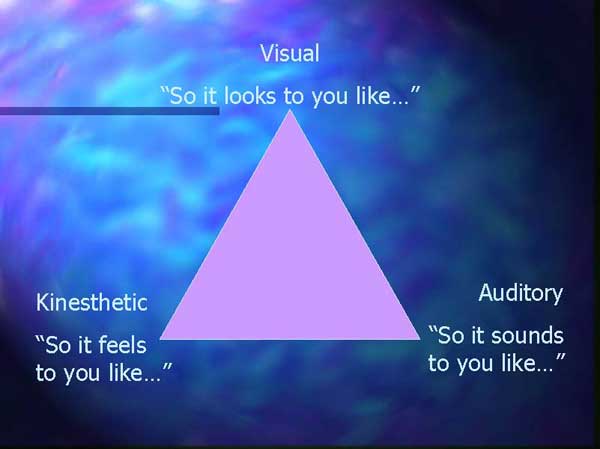WordPress database error: [Table 'adding_b51201.wp_SBConfiguration' doesn't exist]select * from wp_SBConfiguration where id='1'
Welcome to module 5.4 Return to Dashboard
Module 5.5
Module 5.6
There are some other things you might notice about sensory system use. When people are thinking they tend to physically stimulate the sensory system they are using. When visualising, they sometimes rub their eyes or forehead, raise eyebrows, and point upward with their gestures. To listen to sounds or talk to themselves they rub their mouth, stroke their chin, fold their arms and press on their chest, and lean their head to one side in a “listening” stance. They will often gesture near their ears. When aware of feelings, people tend to gesture downward, and touch the body itself, especially the chest and tummy areas.
Visual breathing is fast and shallow in the upper chest. Sometimes a person holds their breath while finding a picture. Auditory breathing is full, rhythmic, chest breathing. Kinesthetic breathing is slower and deeper abdominal breathing. It’s these differences in breathing that cause the different voice tonalities.In general peoples’ skin colour will be paler, or even greyer, when visualising. Kinesthetic awareness causes the skin to flush more.
When someone is thinking visually (making pictures in their mind, which they may or may not notice consciously) they tend to speak in a high fast voice. When someone is thinking auditorally, a rhythmic, resonant voice is used (It may be melodious if the person is remembering especially the tonal, musical quality of sounds. If the person is simply talking to themselves – auditory digital – their voice may be in a resonant monotone; a “lecture” voice). When someone is thinking kinesthetically, a deep, slow, voice, with occasionally sighing, is usual.
It’s important to realise that we all have the capacity to think in all the sensory systems, and only our preferences vary. There aren’t really “visual people” or “kinesthetic people”.
Usually, the words people use to represent their thoughts (their ‘representational system’) will match the other cues you see and hear (their ‘accessing system’). A person will look up and say “The way I see it…”, or look down right and say “Feels to me like…” or to the left level and say “Sounds to me like…” When they don’t, you know that the person is getting information from one sensory system and explaining it to themselves in another.

For example, a person may look up left and say in a high voice, ‘I don’t know why, but I just feel bad in this place’. In this case it is the picture of what happened before that causes the person to feel bad. The picture is ‘unconscious’ and only the feeling the person gets looking at it is ‘conscious’.
If you have a look in your workbook, you’ll see that there’s a page there where word lists are sorted by sensory system. This is actually a translation dictionary. You’ll notice that where the auditory digital speaker might say attitude, the visual speaker might say view, the auditory speaker could use the word opinion, and the kinesthetic speaker might talk about their position.
Lets practise with this for a moment. How would you translate these into the other systems:
- I wish someone would add some sparkle to my gloomy weekends!
- When people try to show me this, I never really get the picture.
- I’ve been reflecting lately on why my life has so few bright spots.
- My life is screaming out for someone to jazz it up! I wish I could tune out all the echoes of my last relationship.
- I need to sound out what my unconscious mind is telling me to do.
- I’m trying to put my finger on the pulse of this group.
- I need some good solid feedback about how I’m coming across.
- If I can’t get a grasp of it soon, I’m going to let the whole thing slide.